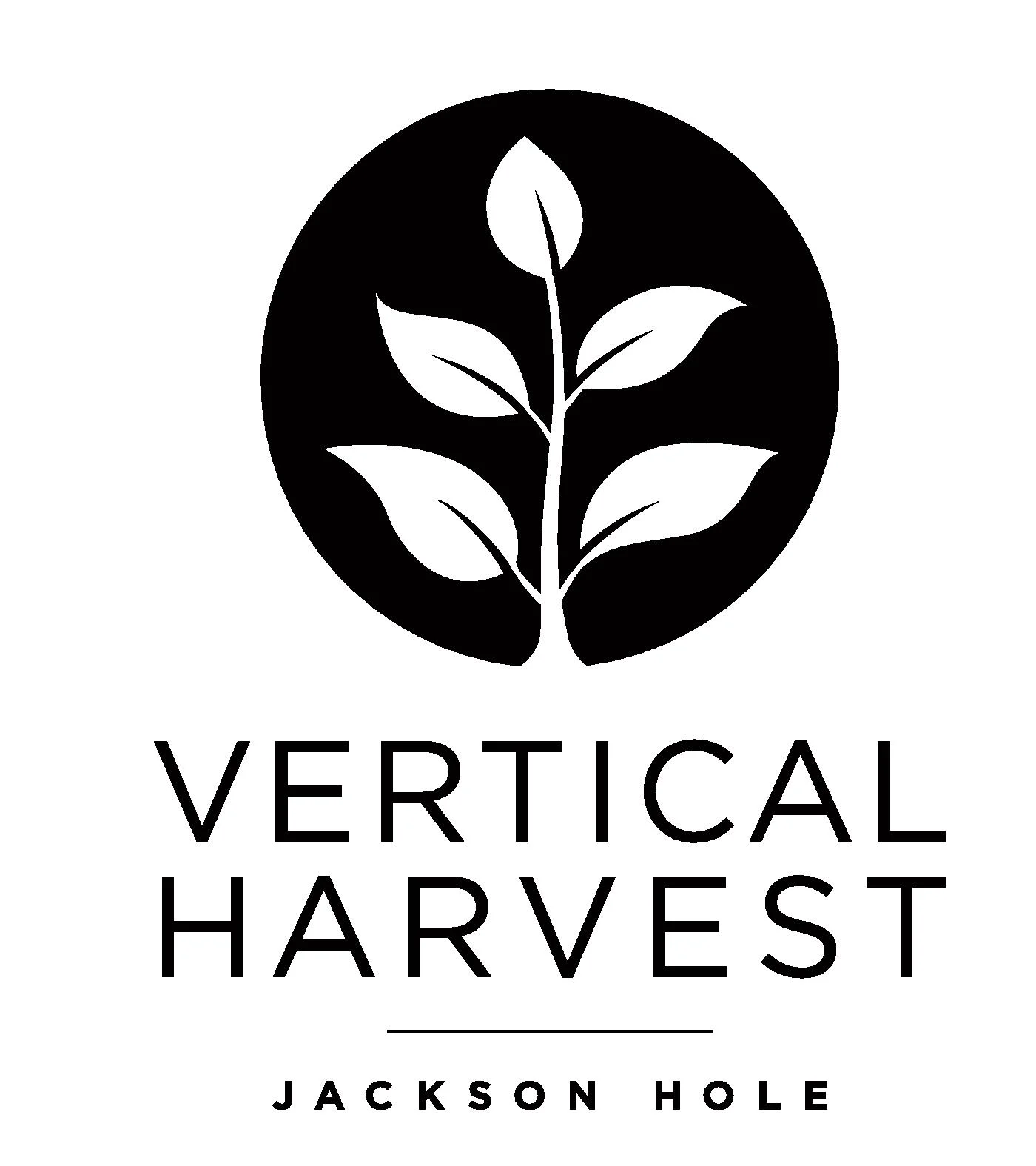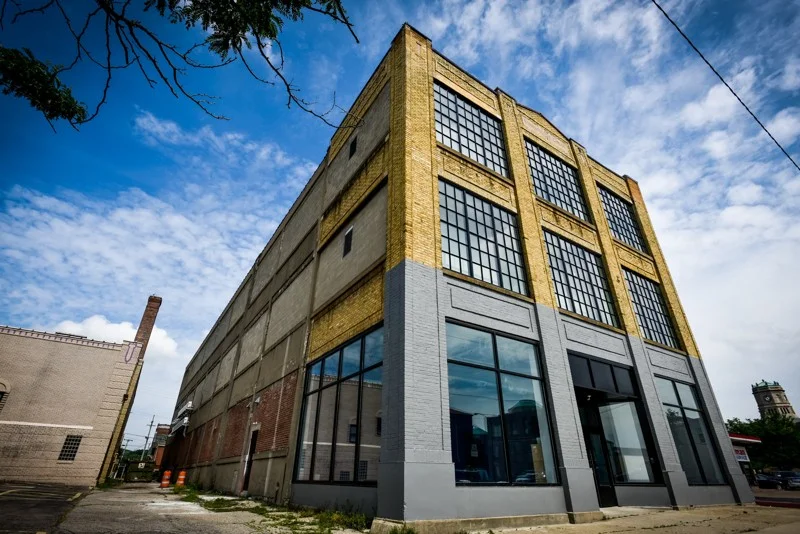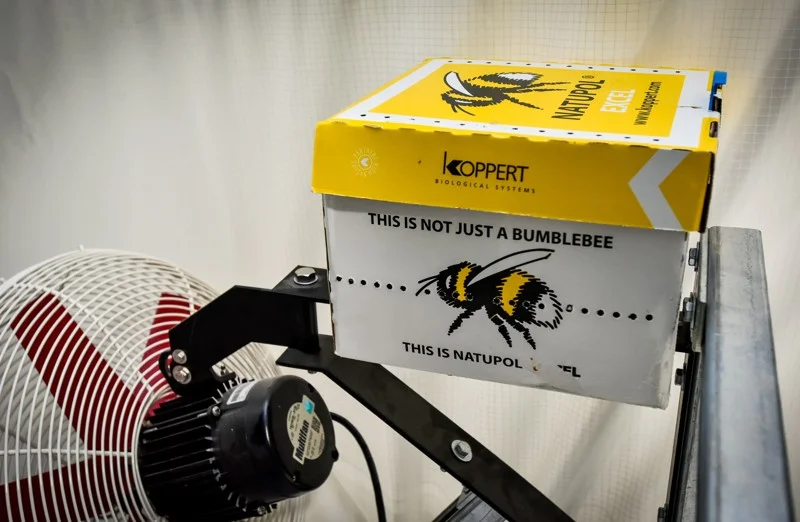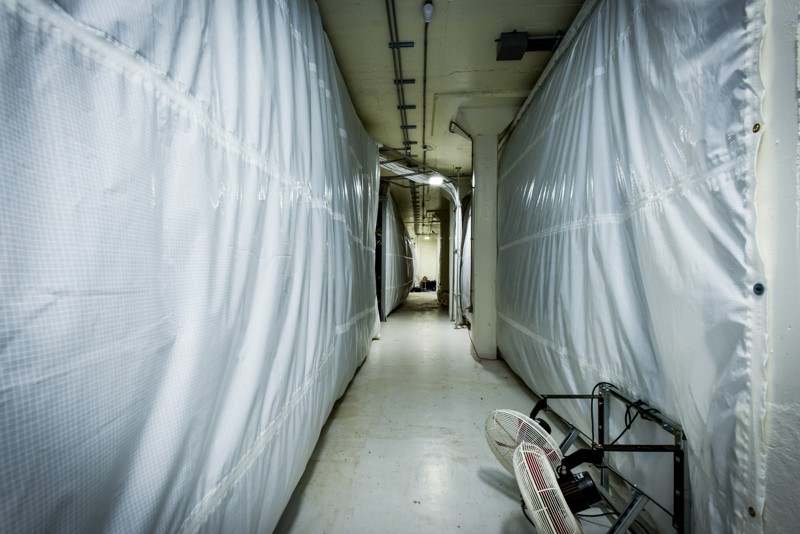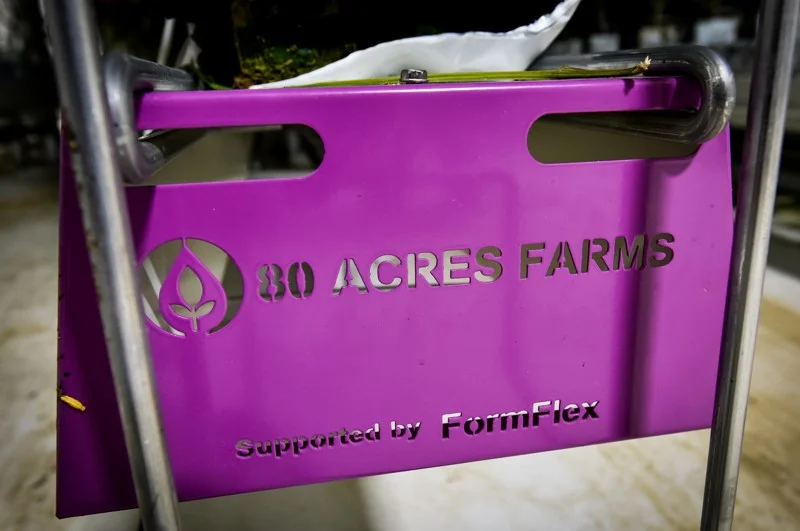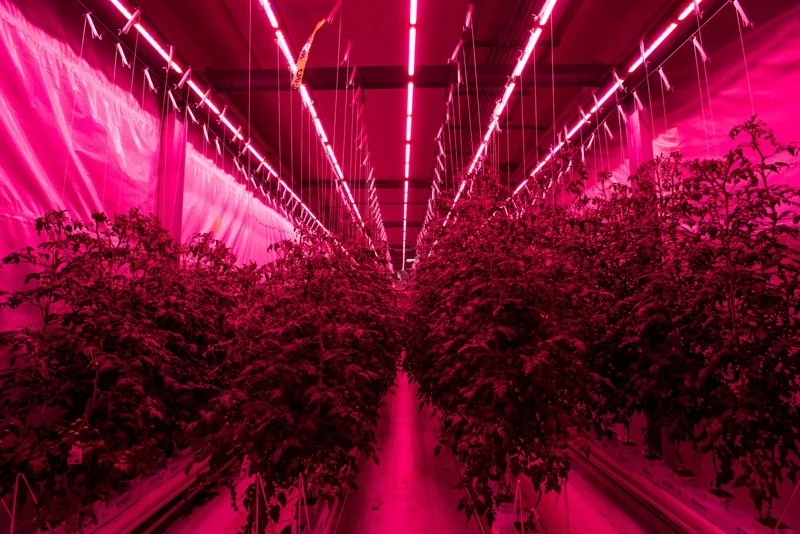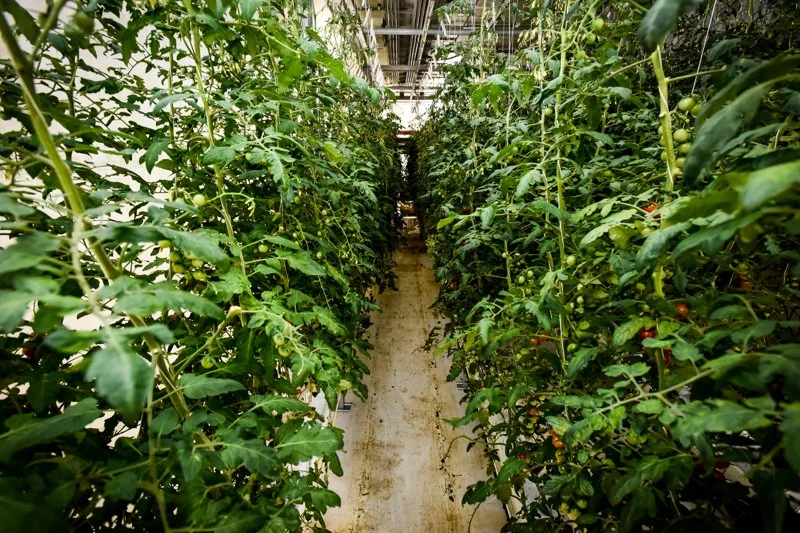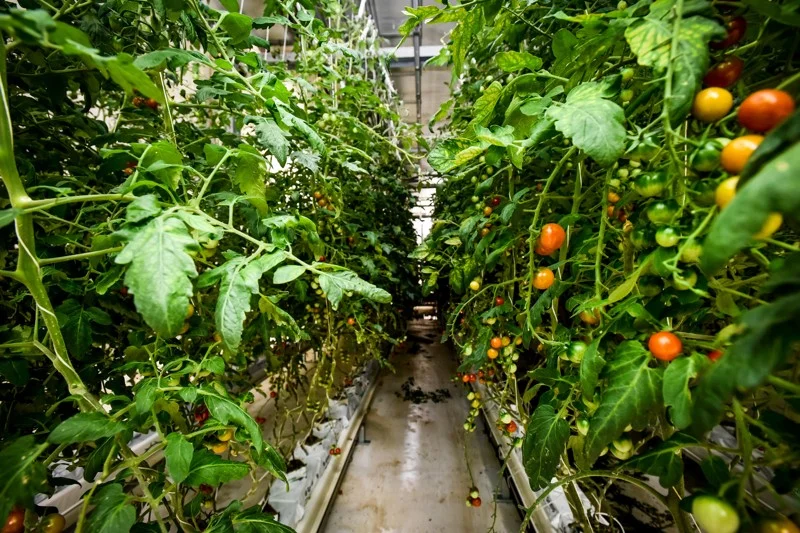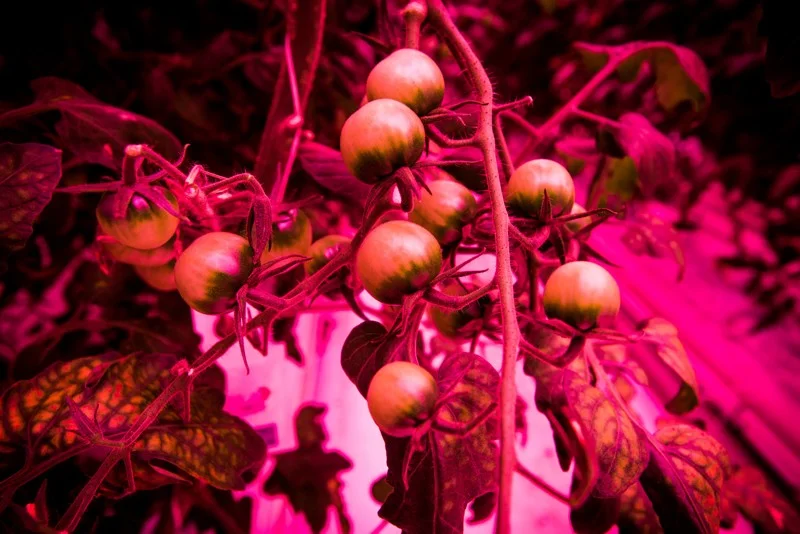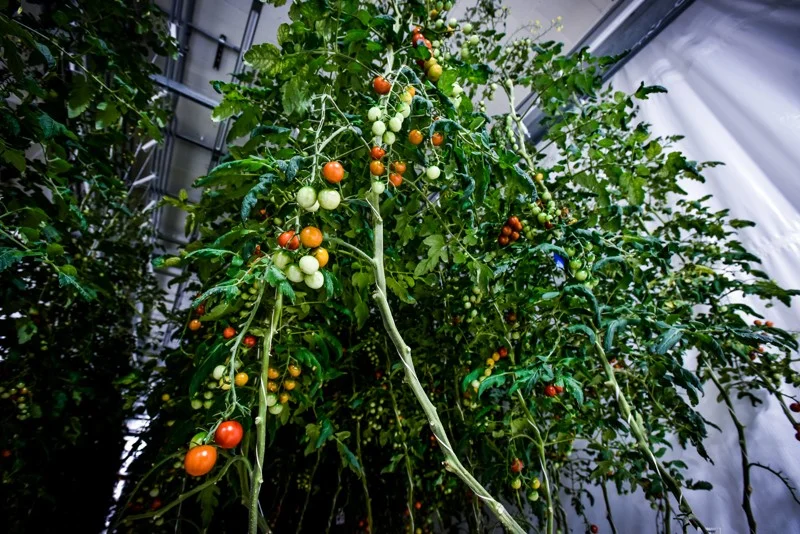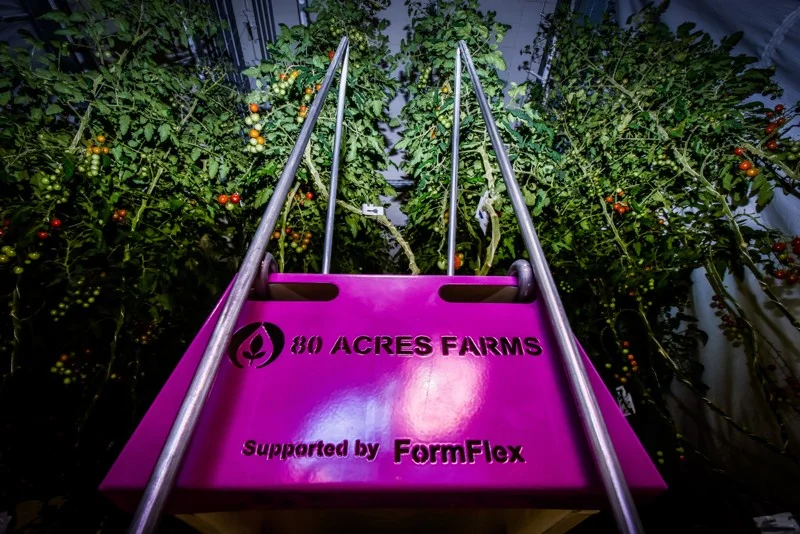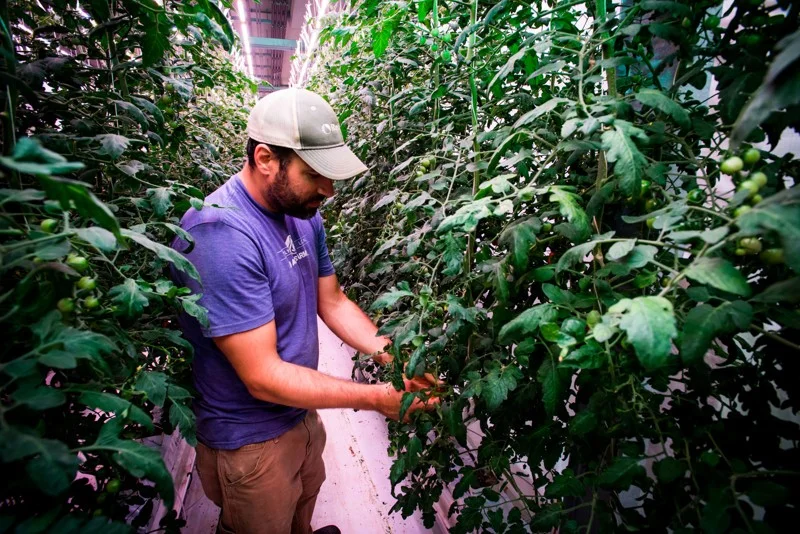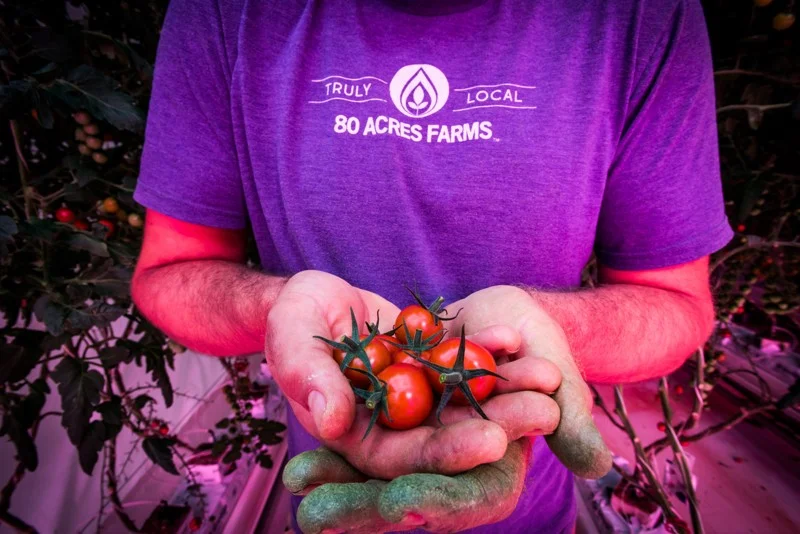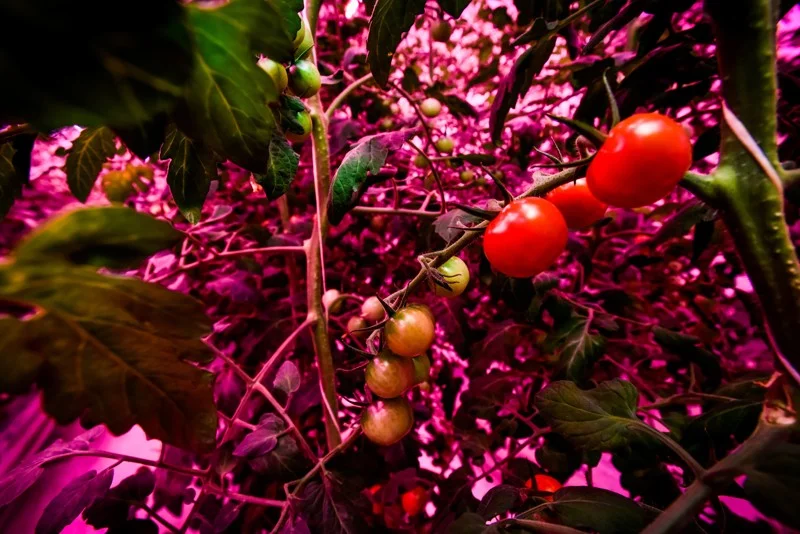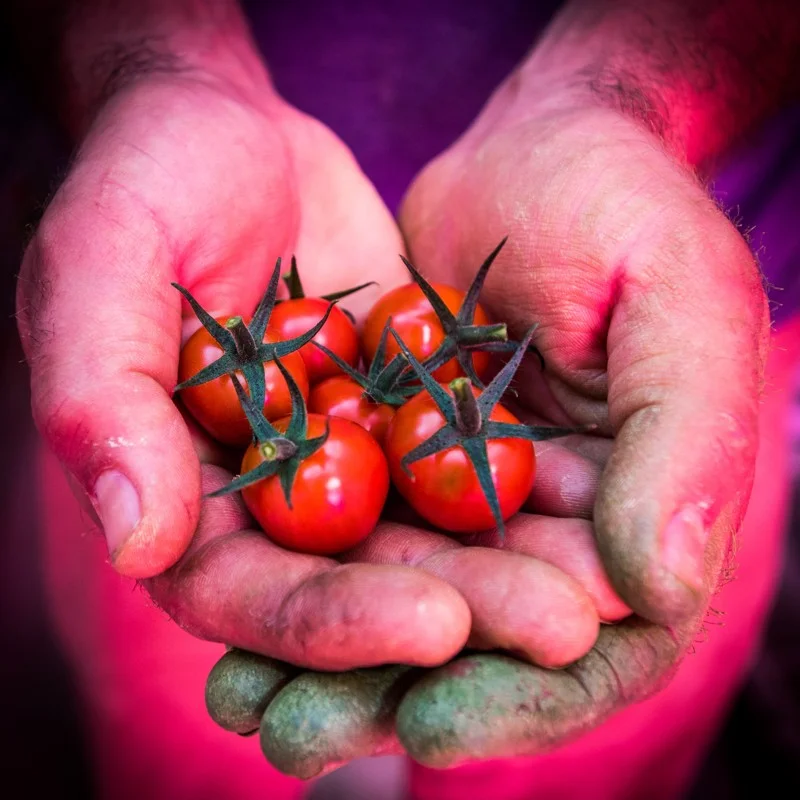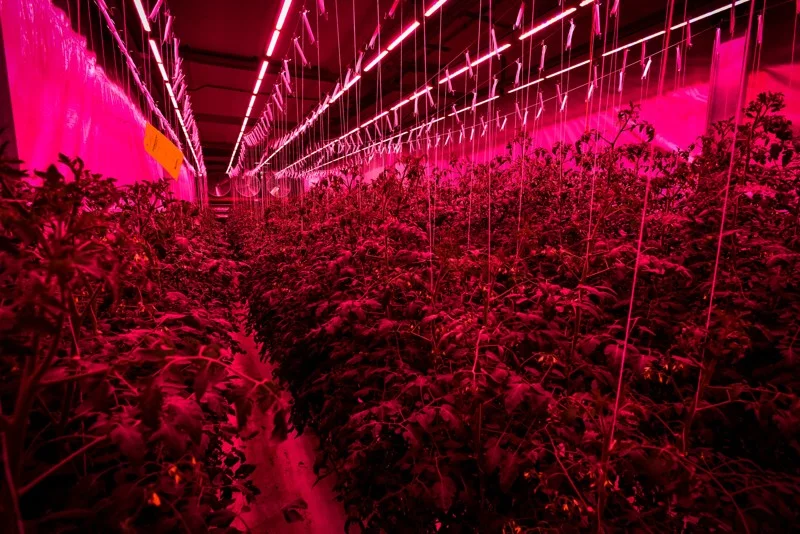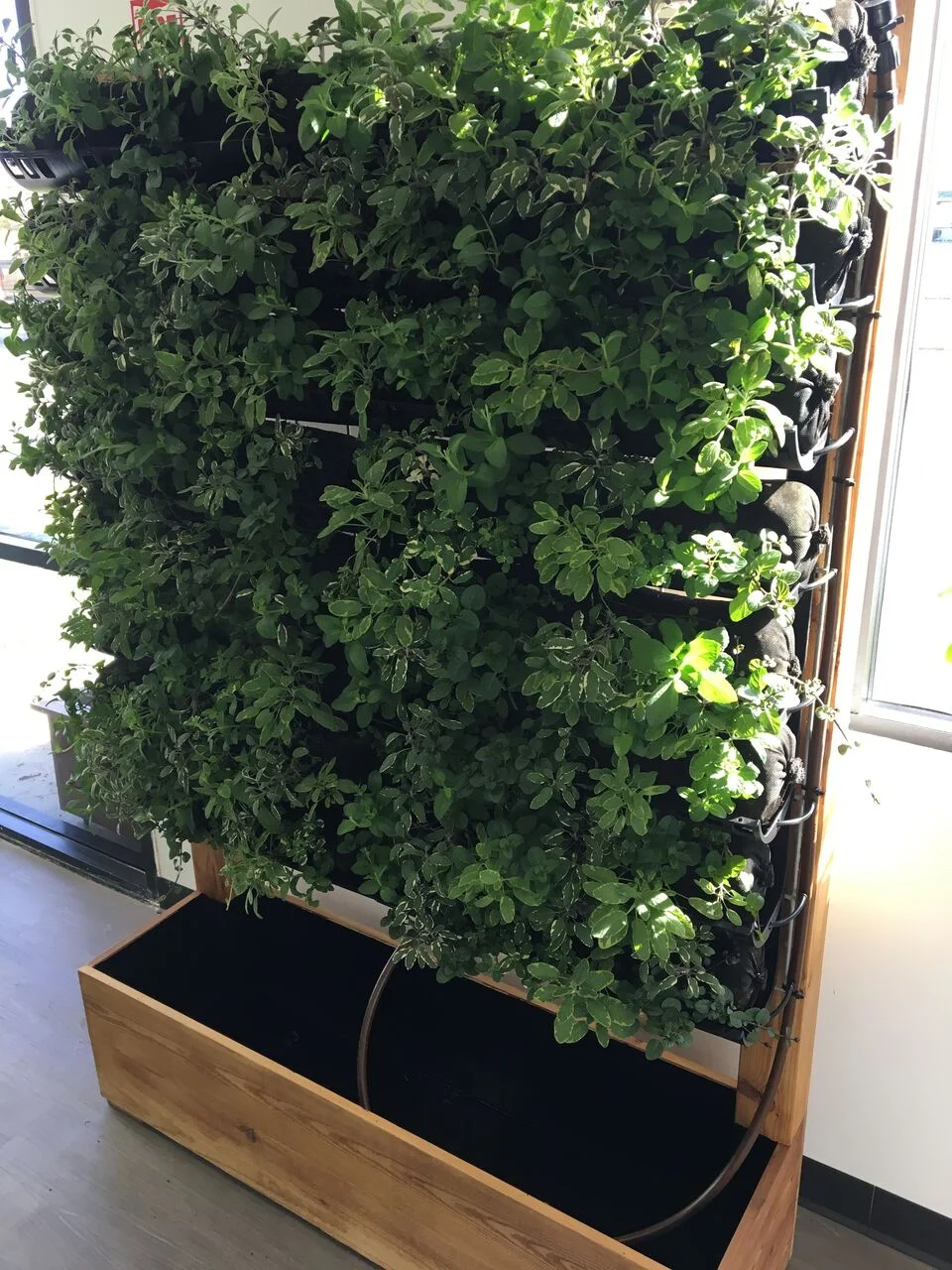
Welcome to iGrow News, Your Source for the World of Indoor Vertical Farming
Start-Up-Nursery From Munich Convinces Food Service Industry With Microgreens From Vertical Farming
Urban & vertical farming-projects are becoming more and more present in the current, modern agriculture
"We Want To Offer A Sustainable And Regional Alternative To Cresses”
Urban & vertical farming-projects are becoming more and more present in the current, modern agriculture. For example, the South-German city of Munich has recently got their own regional cultivation project: under the name of Munich Micros, an ambitious team of innovative growers brings around 25 types of local cultivations to market. After the success in regional wholesale and food service industry, the cultivation company intends to steadily increase the production capacity as well as the product range.
The success story started 4 years ago when the growers were deepening their knowledge of the advanced vertical-farming-technology in Canada and the United States. This brought forth the idea of getting a similar cultivation project off the ground in the German region of Munich. “The theme of vertical farming, also known as indoor farming, first came to mind in my kitchen. Little by little, we worked out the idea and ended up with a test project which led to our first production. After receiving positive feedback from many different star chefs we ended up in the current production hall in Munich-Planegg last year. In May of 2018 – after three years of experimenting – we could finally set up our company and had a product at our disposal that could compete with the best in the world”, co-founder and company director Kevin Jühlcke says.
In no time at all, the high-tech cultivation company has been able to realize a successful distribution channel. A part of the harvest is being traded right away, according to Jühlcke. "Our USP is the fact that we can offer breeds that are not available anywhere else. On top of that, we also offer the guarantee of the product being locally produced. At its core our product is comparable to Koppert Cress, at the same time however, we are polar opposites. After all, Koppert is a giant industrial group and our ideas about offering sustainable and regional alternatives are in stark contrast to theirs.”
Exclusivity in wholesale
Most of the microgreens are being sold by two exclusive wholesale companies – Hermann Fischer KG and Früchte Feldbrach GmbH – and mainly ends up in local bars and restaurants, and institutions. Due to the regional production and modern cultivation methods, there is still a lot of interest in a new product range, says Andre Bukethal on behalf of Früchte Feldbrach, located near the wholesale market in Munich. “Thanks to our exclusive cooperation with regional cress-growers we now also have an interesting USP on the wholesale market. Besides that, to a trader like us, it’s also important to actively support regional growers when they take an initiative if we can.“
The new product range is not only making a name for itself in Munich and its surrounding area: after all Früchte Feldbrach has also been able to find a few new customers in the area of Regensburg, says Bukethal. “Around this time, restaurant owners are creating their new menus and because of that are looking for new, regional specialties they can offer. For this reason, we are promoting our product once more, and quite clearly, via word-of-mouth advertising as well as via our new and improved company website.”
Sales outside of the region?
Parallel to the steady development of the Munich Micros GmbH brand it will eventually become inevitable that we will also start selling our product outside of the region's borders. In this case, as well, people are trying to find an innovative solution with which the regional character of the cresses won't be compromised. Jühlcke: “The next step, of course, is to also supply our products outside of Munich. Ideally, we can eventually start outsourcing our production by opening up multiple indoor farms in the locations we need them to be. This way we can also sell regional cresses there. The dilemma, however, is that we are currently operating in such a High Quality-segment that growing too big would not be ideal either. In certain situations, the risk of growing too big will lead to a loss of product quality.”
At the moment, the terrain we operate on still offers plenty of opportunities to expand on our current capacity. The team of growers is working on a fitting and modern solution to realize this increase in scale. “One of our owners is an expert in the field of automation and together we work on a concept with which we will be able to use sealed containers and solar energy to cultivate despite outside temperatures. We could also move the containers to a different location if needed and have the production coordinated on location by 1 or 2 employees. This is where we as a company are trying to head towards.”
25 Cresses-breeds, available 365 days a year
On the current location – despite the weather conditions – we are already continuously producing the same amount of products. “We can produce the same quality product 12 months a year. With 18 mono varieties and an additional amount of mixed breeds, our core product range exists of 25 varieties that are available year round. In certain cases, we also provide exclusive cresses breeds to individual restaurant owners. Compared to the Koppert Cress-catalog, we have also developed some entirely new breeds like leaf mustard, basil mix with 5 varieties and a special protein mix intended for vegetarian cuisine. The next step is to realize the production of sweet cresses: we are currently developing a new type of wheatgrass with a sweet and pleasant taste.”
According to Jühlcke there is not only a notable trend regarding healthy foods but also an increasing trend concerning the transportation and origin of the product. “What hides behind a product? Where does it come from? These are the most important themes within the fresh produce industry together with the uncompromising freshness of the product. Everything that is delivered per day has been harvested in the early morning of that same day. This means that our products need to go through the entire supply chain in just a couple of hours.” Jühlcke knows that is also customary to provide this same service with their new products: “Our product range will be developing in the direction of edible flowers, different types of lettuce, herbs, and baby-vegetables in the years to come.”
This article previously appeared in the 4th edition, the 33e volume of the AGF Primeur trade journal. See www.agfprimeur.nl.
For more information:
Munich Micros
www.munich-micros.de
Kevin Juehlcke
munich.micros@gmail.com
Andre Bukethal
a.bukethal@fruechte-feldbrach.de
Publication date: 6/28/2019
© HortiDaily.com
The Urban Farm Concept
Urban farming is becoming increasingly popular and is now at the heart of a growing number of business models that want to address the needs of fast-growing urban markets looking to source fresh local produce
Urban farming is becoming increasingly popular and is now at the heart of a growing number of business models that want to address the needs of fast-growing urban markets looking to source fresh local produce.
While it may be true that the costs of developing new facilities will increase the cost of production, the reduction in the costs associated with transporting produce to an end market, both economically and environmentally, more than offset this.
In the UK, for example, Ocado is investing £17m in a high-tech vertical farm which is to run alongside its robot-run distribution centres, and the company said that it plans to roll this concept out around the world.
The vertical farm, Jones Food, currently grows around 420 tonnes of basil, parsley and coriander a year in stacked trays using LED lights to encourage growth.
Ocado will be looking to use its experience and expertise in robotics and AI to help make the Jones Food operation more efficient.
According to senior management at Ocado, the company is also forming a joint venture – Infinite Acres – with a US-based vertical farming business 80 Acres and Priva, a Dutch horticultural technology provider. 80 Acres currently grows tomatoes and courgettes as well as leafy salads and herbs, without using pesticides.
The concept of vertical or urban farming is becoming more popular and at its heart it looks to help retailers to better address fundamental consumer concerns such as seasonal availability, freshness and sustainability.
Unlike traditional farms, urban farms look to control every aspect of a plant’s growth - but that can prove very expensive to enable.
“When we talk about urban farming it’s about getting the farm closer to the end market. Today, much of what we think of as fresh has had to travel miles before getting to a store,” explains Bruno D’Amico, Design and Product Manager at Current, part of GE. He continues, “It means that by the time you eat it, it could be months old. Take apples or onions, for example, these are products that if stored correctly can have a very long storage life.
“The idea of being fresh depends on where it was sourced. The urban farm is about how you can get the farm nearer to urban centres and produce food locally.
“New technologies are helping to revolutionise the way in which we can access fresh produce,” D’Amico suggests.
Industrial scale food production
Current offers horticultural LED lighting systems that have been designed to maximise the potential of urban farms and to support industrial scale levels of food production.
“We provide data to help better understand what is happening in the local environment. So, we’ll look at occupancy rates and temperature, for example, and that data is then made available to the customer to better support the specific outcome they’re looking for.”
Light is obviously one of the most crucial elements when it comes to plant growth, yet while the sun’s light spans a broad spectrum – from UV through to infrared wavelengths – the available light spectrum can be affected by things like geography, the weather and the changing seasons.
“Different plants have different light needs and today it is possible to vary the light ‘recipe’ to some extent, enabling greater control over how plants grow,” explains D’Amico. “However, when you talk about urban farms a lot will depend on the buildings and facilities that are used.
“These farms can be located in a warehouse or in a tower block. If you look at a lot of entry level farms, many have started in an apartment before moving to a larger space.
“If you look beyond these kind of ‘start-ups’, increasing numbers of serious investors are looking for an optimum growing space and will consider building suitable facilities – all of which will require the collection of environmental data.”
Whatever the facility lighting, while vital, is just one of the things that need to be considered. Air flow will be crucial along with water circulation and applying the right amount of nutrients.
“Air flow management is critical, especially in vertical farms,” D’Amico explains. “There are certainly some basics that need to be addressed, but a lot will depend on where you are growing and the type of building that you are using – it means that a lot will need to be managed.”
The use of LEDs and their ability to process light generation, extraction and re-absorbance and the fact that they can run indefinitely, means that they can offer farmers much greater control over their crops - whether that is to promote leaf coverage, fruit generation, plant or leaf mass.
“Light can also prove critical when it comes to the management of pests, bacteria and fungal pathogens and can be used to create ‘traps’ that prevent threats spreading across crops,” explains D’Amico.
According to D’Amico, the urban farm sector is benefitting from two big trends – a growing urban population and worries about the environment.
“We are seeing large investors looking at issues around the environmental impact of farming and whether it is sustainable, and how technology can then be used to address these problems at the top level.
“When it comes to urban farming we are seeing the development of both mega urban farms, with large buildings and a large footprint, as well as strong growth in much smaller farms too. These farms look to support local grocery stores and restaurants, for example. It’s hard to say which is gaining the most traction, but both are growing.”
Lighting solutions
Current is involved with a number of projects that are using its lighting solutions, but it is also supporting job training and education in a bid to help develop more local food systems and a greener approach to farming.
Current has installed 12km of its Arize LED solution in a new facility owned by Jones Food, which is now working closely with Ocado. The equipment is housed in a state of the art facility which has been designed to enable crops to be grown in isolation away from external contamination.
“Lighting is the life blood of the facility,” said the company’s CEO James Lloyd-Jones, “and Current was able to provide the right lighting set up and spectrum.”
“We’ve developed Arize Lynck LED Growlights that by isolating and combining different light wavelengths are able to replicate and accelerate natural photosynthesis and thereby reduce growth cycles,” explains D’Amico.
“Plants are sensitive to blue and red light spectrums and by varying those spectrums – we can offer seven variations – we are able to encourage different growth patterns.
“We approach our customers with a spectrum, look to understand the outcome they are looking for and work with them to give them the right light to support their needs.
“We don’t just focus on the lighting perspective but try to better understand the entire environment.”
According to D’Amico the benefits of the LEDs come in the form of ease of installation, a reduction in operational costs and much greater levels of reliability.
But the issue, D’Amico suggests, is not only about sourcing fresh food locally, but also providing access to food where accessibility can be a real problem.
“Can an urban farm be relocated to remote areas to source food locally food?
“A good example of this is how our LED lighting solution has been used by the Big Tex Urban Farm to grow crops. Partly an innovation lab as well as a production facility, it has used our LED solutions to grow food for isolated desert communities.”
The farm originally comprised of just 100 raised garden boxes but after significant investment Big Tex was able to produce 11,000 pounds of food in 2018, which translates into 140,000 servings, using the Arize LED lighting system to provide optimal light spectrums to drive plant growth.
The red spectrum encourages flowering and fruit generation, while the blue produces much thicker leaves. A combined red-to-blue mix has helped to encourage much greater overall growth.
“Critically, these LEDs have been able to produce better crops, quicker. But they are longer life, require less maintenance and less heat than more traditional forms of lighting,” says D’Amico.
Urban agriculture can happen anywhere and the technology being used is making it more viable economically, providing an incredible opportunity for growers everywhere.
Vertical Harvest To Study Expansion of Greenhouse Concept Into Chicago
An innovative greenhouse that backs up to the Millward Street parking garage now has $500,000 in hand to study expanding into Chicago
With $500K Grant It Will Look At Potential For
Vertical Greenhouses At Housing Developments
June 26, 2019
Michele Dennis deposits sweet mix in Vertical Harvest’s revolving planters in May. The private-public partnership was recently awarded a $500,000 Fannie Mae grant to study an expansion into Chicago.
An innovative greenhouse that backs up to the Millward Street parking garage now has $500,000 in hand to study expanding into Chicago.
The Federal National Mortgage Association, or Fannie Mae, awarded Vertical Harvest a grant of that sum through its Sustainable Communities Innovation Challenge.
The grant program is a partnership with the National Affordable Housing Trust, which presents exciting prospective growth opportunities for the community greenhouse formed a decade ago by valley residents Nona Yehia, Penny McBride and Caroline Croft Estay.
“I think the National Affordable Housing Trust has 1,452 sites that they’re going to be developing in the next 10 years,” said Sam Bartels, Vertical Harvest’s business development director.
“Jackson has always been our proof of concept and our pilot,” she said. “We’ve had people from all over the world contact us on a weekly basis about how they could do this.”
While adding Vertical Harvest-like facilities around the country and planet may be the long-term vision, the product of the grant is initially much more narrow. The half-million dollars will be put toward a feasibility study that will analyze the efficacy of building vertical greenhouses at three existing affordable housing developments in the Chicago area, Yehia said.
The study will assess what model of greenhouse could be integrated into the developments, and what products would best serve the Midwestern metropolis market. It will also look at programs that could be integrated into greenhouses and that provide ancillary benefits for the community, she said.
“Could you put a commercial kitchen in there?” Yehia said. “A food hub? Or even a day care center?”
The existing Vertical Harvest is far from an ordinary business. It’s a public-private partnership, for one, relying on town of Jackson property, and funds from the Wyoming Business Council and philanthropic groups and people. More than a dozen employees at the three-story central Jackson workplace have special needs, and volunteers assist as well.
“Vertical farming is the fastest-growing industry of farming,” Yehia said. “It’s such a nascent field, and it has so much potential impact. We’re really the only ones looking at the social impacts.”
Vertical Harvest’s annual harvest is around 100,000 pounds of produce, all hydroponically grown on 1/10th of an acre.
Yehia anticipates the study, which will be authored by in-house employees, will take about 18 months to complete. Work is set to start in October. This next step of Vertical Harvest’s evolution is “exciting,” she said.
“From the get-go this is what the team had in mind: to grow and replicate this model,” Yehia said. “We’ve always had our eye toward that end goal.”
Yehia’s architectural firm, GYDE Architects, is collaborating on the study.
Contact Mike Koshmrl at 732-7067 or env@jhnewsandguide.com.
The Urban Farm With A Global Growth Plan
BY EUGENIO FELICE
Tuesday 18th June 2019, London
Reckoned To Be Europe's Largest, Most Advanced Vertical Farming Site,
Italy's Planet Farms Could Soon Appear Elsewhere
Luca Travaglini pictured at Planet Farms' Milan-based laboratory
Produce more food, of better quality, using fewer resources. Luca Travaglini and Daniele Benatoff’s message to the Triennale exhibition in Milan was crystal clear: their start-up company Planet Farms is planning to build Europe’s largest and most advanced vertical farm, then establish similar projects in other countries around the world.
Work on the new centre begins this month and is due for completion in spring 2020. Located in Cavenago, halfway between Milan and Bergamo, the farm will eventually extend across 9,000m2 and supply 40,000 packs of produce per day. Inside, an innovative growing process from seed to packaged product is set to turn out zero-residue fresh produce that will impress in terms of their taste, long shelf-life and high level of sustainability.
“Vertical farming is to agriculture what Formula 1 is to cars,” say Travaglini, an apt description given the centre is just a few minutes’ drive from Monza’s world-famous race track. Planet Farms will employ state-of-the-art technology to grow babyleaf salads, basil and other aromatic herbs in a completely controlled environment situated right at the point of sale, 365 days a year. A capillary system of sensors allows the entire production process to be monitored constantly and, because the entire process is automated, Planet Farms says the consumer will be the first to touch what is a completely fresh product. Each plant will grow from a traditional seed in pure air and water, without the need for pesticides, with water usage minimised.
The new structure could be just the start as far as Planet Farms’ ambitious global development and growth plan is concerned. In fact, it aims to make Lombardy a vertical farming capital by exporting its model throughout the world, as co-founder Benatoff confirms: “The Cavenago plant represents the starting point on a path that will take us all over the world, a project that speaks Italian and that will soon see new concrete applications both in Italy and abroad.”
An architect's rendering of how the new vertical farm will look
As with any F1 team, lots of other specialists are involved behind the scenes, including architect Studio Dordoni, lighting provider Signify, Travaglini FarmTech, WoodBeton, Sirti, 255, Repower and Netafim. Travaglini, which has years of experience in food production, is helping to plan and construct the farm’s air conditioning systems – with a focus on energy efficiency – and its clean packing rooms, where the aim is to minimise the risk of contamination from outside. Philips spin-off Signify, meanwhile, previously worked with Planet Farms on its research laboratory and is supplying Dynamic Philips GreenPower LEDs that can be fine-tuned to every type of vegetable.
“From 2020, the Cavenago facility will produce 800 tonnes of salads and aromatic herbs a year, which is equal to 40,000 packs per day,” comments Luca Travaglini. “The process, which is completely automated and checked, goes all the way from seed to end product. Air, water, light and soil, these are all variables that can be controlled: we will be the first to use clean rooms to control the air; the water will be sterilised and integrated only with mineral salts, plus we will use 97 per cent less compared with traditional agriculture; the lighting will be high-efficiency LEDs that use only the spectrum of light needed by the plant; and the soil will be substituted by organic substrates designed specifically for each crop.”
The advantages of such a system are clear, Travaglini adds. No longer constrained by weather conditions in the outside world, Planet Farms can in theory grow any product wherever there is consumer demand. “We can even rediscover ancient flavours using seeds that can no longer be used in traditional agriculture,” he suggests. “A few hours after packing, we will deliver a product that is healthy because it is rich in vitamins and antioxidants, and free of pesticides that scare today's consumer. It will also be a taste explosion, which is the paradox of vertical farming: we are rediscovering the real flavours that we no longer find in our dishes. For us, this was the primary goal and our biggest challenge.”
The result, it would seem, is that the end consumer will be the first to touch that chemical-free, crunchy, tasty salad, without needing to wash it before eating. But for Travaglini, vertical farming should not be seen as a replacement for older methods of production. “Our research and innovations can then be transferred to traditional agriculture,” he says. “We cannot and do not intend to replace it.”
High-efficiency Philips lighting will be used in the centre's clean rooms
This article is translated from the original Italian article, which can be found on the Fruitbook Magazine website.
France: Carrefour Inaugurates A New Urban Farm On The Boulevard de Charonne In Paris
It was at 103-105 boulevard de Charonne in the 11th arrondissement of Paris that the Carrefour Group’s second urban farm was installed
It was at 103-105 boulevard de Charonne in the 11th arrondissement of Paris that the Carrefour Group’s second urban farm was installed.
The 800 M2 store run by Cédric Lobo was opened in August 2018. The store was created on the site of a former biscuit factory. As part of a partnership of the Carrefour group with the start-up Agripolis, the terraces (300 M2) of the store were developed by Agripolis. T
The company headed by Pascal Hardy is specialized in the transformation of roofs or flat surfaces into an urban farm. On the terrace of the Boulevard de Charonne store, two techniques were favoured to grow about fifty varieties of fruits and vegetables.
The first, hydroponics, allows tomatoes to grow on a substrate – in this case, glass wool – and in a closed hydraulic system. The second, the aeroplane, used for leaves (salads, spinach, aromatic, strawberries …) favours a column system. The roots develop in the open air column.
Since last week, the first strawberries grown on the terrace of the store are offered for sale at a price of € 3.90 for a tray of 250 grams. “All our trays left very quickly. Our clients followed the progress of our project on social networks. The promise of these strawberries is clear: they are grown without pesticides and are picked at maturity because they are not transported, “enthuses Cédric Lobo.
The production of strawberries but also salads, herbs, tomatoes, aubergines, peppers are maintained by Camille, a young market gardener from Agripolis who, in close collaboration with the head of the store’s fruit and vegetable department, takes care of the harvest.
In a few weeks, Cédric Lobo has the project to open the terrace of the store to customers to show them closely how these fruits and vegetables are grown. “By next year, we hope to grow melons,” says the store manager. From one day to another, production exposed to climatic hazards can vary. “This is the main difficulty, but as long as you explain it, customers are ready to accept it,” says Cédric Lobo.
Source: lsa-conso.fr
Tech Farming Is Making Its Way To Grand Rapids, Michigan
Square Roots, an urban indoor farming company, will bring its Next-Gen Farmer Training Program to Grand Rapids in September. The goal of the program is to train young people in indoor urban farming and grow localized food and herbs year-round in technology-driven environments
Partnering With Gordon Food Service, Square Roots
Aims To Train Young People In Indoor Urban Farming
June 21, 2019
| By Danielle Nelson |
Jacque Kirila and Em Helle harvest sage at a Square Roots indoor farm, which is comprised of repurposed shipping containers. Courtesy Square Roots
One company is hoping to shake up the landscape of farming.
Square Roots, an urban indoor farming company, will bring its Next-Gen Farmer Training Program to Grand Rapids in September. The goal of the program is to train young people in indoor urban farming and grow localized food and herbs year-round in technology-driven environments.
The company will partner with Gordon Food Service to distribute food that is grown by farmers enrolled in the training program to its consumers and retailers across the country.
“Customers want an assortment of fresh, locally grown food all year-round,” said Rich Wolowski, CEO of Gordon Food Service. “We are on a path to do that at scale with Square Roots and are excited to be the first in the industry to offer this unique solution to our customers.”
According to Square Roots, 10 full-time farmers will be chosen through an application process to learn all aspects of farming, from the planting of the seeds to the selling of the produce. They will receive a wage, subsidized health care coverage and other benefits.
The year-long program enables farmers to study the molecular level of the plant as it grows, get hands-on experience with the business side of farming so they can pursue a start-up indoor urban farm and get involved with the community.
Square Roots’ training program was created with advice from experts in farmer education, controlled environment agriculture, regenerative agriculture and urban agriculture, including Glynwood, New York University, Cornell University and the University of Arizona. There will be guest lecturers who will talk about farming and entrepreneurship. There also will be workshops, which will cover a variety of topics, such as pest management practices to real food entrepreneurship frameworks.
The farmers will work in indoor vertical farms that are constructed in 10 specially designed Square Roots shipping containers that will occupy less than 2 acres of Gordon Food Service’s 50-acre headquarters site in Grand Rapids, but it is expected to produce more than 50,000 pounds of herbs annually. Each container will have its own controlled climate that is optimized for growing certain crops. The cloud-connected modular farms will have hydroponic growing systems to water the plants.
“Because we grow in a completely closed environment, we have full control over each climate parameter — from CO2 in the air to the number of hours of light,” Square Roots officials said. “We research the best natural climate for a certain variety of plant, recreate it inside the farm and grow the best tasting produce 365 days a year.”
Gordon Food Service will not only provide a place for urban indoor farms, but farmers from the training program will work with the food service company. The farmers are expected to grow food on a consistent basis to meet the standard of Gordan Food Service and the demand of its consumers.
Additionally, Next-Gen farmers will have the opportunity to represent Square Roots at customer-focused engagements, marketing activities and community events, where farmers can connect directly with customers.
The Next-Gen Farmer Training Program was started in Brooklyn, New York, in 2016. So far, 16 farmers have completed the program, according to Square Roots. Some farmers in the program have either started their own urban farming businesses, taken jobs at companies in urban agriculture or moved into permanent positions on the Square Roots team.
According to the Michigan Department of Agriculture and Rural Development, the food and agriculture industry contributes $104.7 billion annually to the state’s economy and accounts for about 22% of the state’s employment.
Square Roots said its end goal is to be a pathway for future farmers in the urban farming industry in cities around the world. More information can be found at squarerootsgrow.com/program.
Danielle Nelson
Danielle Nelson is a Grand Rapids Business Journal staff reporter who covers law, startups, agriculture, sports, marketing, PR and advertising and arts and entertainment. She is also the staff researcher who compiles the weekly lists.
Email: Danielle at: dnelson@grbj.com
Follow her on Twitter @Dan_Nels
TAGS GORDON FOOD SERVICE / NEXT-GEN /SQUARE ROOTS
A look Inside Balance Farms, Downtown Toledo's Aquaponics Operation
Hidden from prying eyes and tucked beneath a four-story steel and concrete parking garage in the heart of downtown Toledo sits the most unlikely of things — a farm. But this one has no tractors, silos, or scarecrows
JUN 21, 2019
JON CHAVEZ
Hidden from prying eyes and tucked beneath a four-story steel and concrete parking garage in the heart of downtown Toledo sits the most unlikely of things — a farm.
But this one has no tractors, silos, or scarecrows.
Go inside Balance Farms, an 8,168-square foot high-tech “aquaponics” operation located on the first floor of the Tower on the Maumee’s parking garage on Summit Street, and you will find multiple rows of tall racks filled with herbs and leafy greens that are growing robustly in black plastic trays.
Each tray is bathed by ultraviolet light and filled by a three-layer sandwich of nutrient-laden water, shredded coconut husk, and a styrofoam sheet with rows of neatly-spaced holes to hold the hydroponically-grown crops.
“There’s never a rainy day, there’s never a cloudy day in here. We have a controlled light spectrum that gives each plant exactly what they need, and we go from seed to harvest in about four weeks. Every week we’re harvesting about 500 heads of lettuce,” said Prakash “P.K.” Karamchandani, of Balance Pan-Asian Grille, which is the prime beneficiary of Balance Farms’ bountiful and organic harvests.
Mr. Karamchandani and his business partner, HoChan Jang, co-own the Balance restaurant chain, which they founded in 2010 on a premise of tangy and exotic flavors using the freshest ingredients possible.
But Mr. Jang, the chain’s executive chef, menu planner, and in-house foodie, grew increasingly frustrated that his meal planning and menu experimentation was limited by his produce suppliers.
Some items they could not procure, while others could not be obtained regularly or in consistent quantity.
“I’ve experimented with a lot of different peppers. But for some dishes, they’re just not going to have the genuine flavors because I can’t always get what I need,” Mr. Jang said.
So in mid-2016 the two began investigating a way to get the freshest ingredients, in large quantities, and at the exact time when those ingredients would be needed.
Their $715,000 solution was an aquaponics farm adjacent to their downtown Toledo restaurant.
Aquaponics is a self-contained symbiotic system that recirculates waste water from a fish tank through a vegetable bed. The nutrient-rich wastewater feeds the plants, and the plants filter the water to keep the fish healthy.
Neither of the two owners knew much about aquaponics, so they purchased an existing small aquaponics firm in Toledo, Great Greens, which ran an aquaponics farm in the Uptown neighborhood near downtown Toledo and was supplying greens to a small list of area upscale restaurants.
Balance Farms, which is 15 times larger than the operation Great Greens had, went operational in mid-May and already is supplying lettuce and herbs (mostly basil) to Balance Grille’s four Toledo area stores plus a new store in Cleveland. The basil crop has been large enough to sell leftovers at Walt Churchill’s Markets locally and Plum Markets in Ann Arbor.
Plants grow in a multitude of rows inside the 9,000 sq. ft. Balance aquaponics space.(Phillip Kaplan/The Blade)
About 80 percent of the farm will be functioning by July and Mr. Karamchandani expects production levels to hit 100 percent by 2021. A system that will house fruiting plants like tomatoes and peppers hasn’t been set up yet but should be operating by this summer.
Modern aquaponics has been around only since about 1979 and it didn’t really take off until the 1990s.
“We’re now past it being a fad stage and people want it to work long-term. People are committed to it and it has taken hold,” said Allen Pattillo, an aquaculture researcher and a specialist in aquaponics at Auburn University in Alabama.
However, aquaponics still faces some real hurdles, he added. For one thing, it’s expensive on a per-cost basis.
“It’s hard to make money in agriculture just in general terms. The margins are thin,” Mr. Pattillo said.
With aquaponics, “The profitability, that’s the tough part,” he said.
In regular agriculture, the distribution markets available to produce growers have long since been established. But that isn’t the case for produce grown using aquaponics.
“The biggest problem that most (aquaponics) people have is they have a hard time selling the stuff they grow. It’s a big problem finding markets for it,” Mr. Pattillo said. “If (Mr. Karamchandani and Mr. Jang) can take theirs onto the retail side already in their restaurants and sell the rest to whomever, that’s a great start.”
Currently, Mr. Pattillo said he is unaware of any restaurant chains that are using aquaponics to vertically integrate their supply chain into their overall business.
“There’s a fellow with a place close to Minneapolis. He’s got a garden center and an organic farm and a restaurant. It’s not all on site, but he’s kind of vertically integrating,” Mr. Pattillo said.
A company in Wisconsin, Superior Fresh, is using aquaponics to grow produce on an industrial scale, but it functions as a produce supplier with its crop going to restaurants and retailers.
The jury is still out, Mr. Pattillo said, as to whether the public really cares enough to pay a little more to buy produce grown with aquaponics.
“We all say we would like to buy some of that nicer stuff, but when it comes right down to it, we might not,” he said. “But people are more likely to try those new fancy things in a restaurant than in the store,” he added.
The Balance owners might have saved money by using a hydroponic system instead of aquaponics.
In hydroponics, plants are grown in water-fed trays, but unlike aquaponics the water isn’t recovered and fed back into the system and the grower must continually buy nutrients, seeds, and other items.
Mr. Karamchandani said he and Mr. Jang made the decision to spend more for a system that was organic but that also was largely self-sustaining. Once Balance Farms is fully functional, the only large expense will be seeds, and even that expense might be offset by sales of excess produce, mature fish, and other by-products.
“We’ve tried to monetize every aspect of this project,” Mr. Karamchandani said.
For example, a small part of their crop is a fish food called duckweed. And when the waste conversion tanks become too filled, some liquid can be drained off, bottled, and sold as liquid plant food.
So far, the urban farm project has about 600 fish, mostly tilapia and koi, swimming in 650 gallon tanks. But there is room for 1,200 fish. The fish tanks and additional tanks that mix wastewater and bacteria to create nitrates that plants can absorb are located in a separate room from the plants.
Both plant water and fish water eventually meet in a computer-controlled mixing system that pumps water to one system or another to keep it all balanced. Overall, the fish tanks and water system to feed the plants contain about 26,000 gallons of water.
Inside the plant room, a climate-controlled system using triple filters regulates the air quality and humidity.
Even tiny flies that hover around the plants are there for a specific purpose: they eat mold that can damage plants. And the fly population is strictly controlled — all are females.
If building an aquaponics farm seems like an extreme step to have a “farm-to-table” experience at a fast casual restaurant, Balance Grille’s owners say it’s worth it.
On the food side, Mr. Jang said, Balance can claim without exaggeration fresher and better tasting greens.
“The flavors are much bolder but the textures are so much more delicate,” Mr. Jang said. “The lettuce is sweeter and it has a better texture.”
If menu items call for exotic greens or peppers, Mr. Jang said he now can grow as much as needed. “And it’s not just a certain item. I can grow hybrids. Really, this is a way we can put our own mark on everything we sell,” he said.
On the business side, Mr. Karamchandani said the aquaponics farm enhances Balance’s corporate brand and pledge of freshness. It also will eventually cut costs and provide new revenue streams.
More importantly, it gives the owners a greater measure of control they have long desired.
On its website, Balance promises “fresh meals, where every ingredient is prepared from whole form, right here in the restaurant.” But up until last month, that promise was more a goal than reality.
“Restaurants by and large revolve around delivery of their product by a supplier. But say you’re expecting a shipment of greens,” Mr. Karamchandani said. “Those greens could have been prepped on a Monday and been sitting in a (refrigeration truck) waiting for shipment on a Wednesday.
“All that work for a product that sat on a truck for a day,” he said.
At Balance Farms, produce is harvested at 6 a.m., distributed locally and in use by 11 a.m. at the restaurants, Mr. Karamchandani said.
“This was so worth it for us,” he said. “Food is such a commodity and not needing to give up control on how we get our supply was important.
Plants grow in a multitude of rows inside the 9,000 sq. ft. Balance aquaponics space.(Phillip Kaplan/The Blade)
“Look outside the restaurant industry and there’s vertical integration everywhere. Look at ProMedica and their recent acquisition. That was all about being vertical,” he said.
It takes about six to eight weeks in dirt to grow lettuce conventionally. “We need just four weeks to bring it to harvest and we can rotate crops so that we’re harvesting fresh greens every week,” Mr. Karamdanchani said.
Eventually, 70 percent of everything grown in their mysterious space with covered windows will supply Balance restaurants. The remaining 30 percent will be sold at local grocery stores.
And while Balance Farms is low-key for now, it will not stay in the shadows long.
The two owners plan to show off their investment in an innovative way.
They have an arrangement with Imagination Station to eventually turn their urban farm into a kind of exhibit demonstrating how a sustainable aquaponics farm operates.
Mr. Karamchandani said a live exhibit is a natural fit for Balance’s philosophy.
“People want transparency. They want freshness but they want to be assured how that freshness occurred,” he said. “When this is ready you will see every part, see the entire process of how we grow everything that we put on the table.”
Bowery Farming: Expanding Assortment Outside Lettuce and Leafy Greens
It is one of the favourite topics for critics of indoor farming: how will you feed the world with lettuce? The team with Bowery Farming doesn’t see it as its primarily goal to feed all of the world, but is expanding its produce assortment anyhow
"Just Because It's Possible To Grow A Crop Indoors
Doesn't Mean You Should Do it"
It is one of the favourite topics for critics of indoor farming: how will you feed the world with lettuce? The team with Bowery Farming doesn’t see it as its primarily goal to feed all of the world, but is expanding its produce assortment anyhow. Yesterday at the Indoor AgTech in New York, Bowery Farming Founder & CEO Irving Fain explained how the company is trying out new products like radishes, turnips and kohlrabi, all grown in their own controlled environment. “We’re still excited and see many more opportunities for the leafy greens and herbs market, but have aspirations outside this area as well.”
Irving Fain & Tom Colicchio at Indoor AgTech
Flavor
At the Indoor AgTech Innovation Summit, the role and future of indoor farming is discussed. While there are many challenges, in the talk with Irving Fain and Tom Colicchio, chef and founder of Crafted Hospitality, it became clear that there are new opportunities for indoor farms through partnerships. Tom explained how years ago he would have dismissed any food grown hydroponically, as he believed it not to be any good or tasteful at all - but had his view changed after learning about the flavors that can be achieved with indoor farming, based on the crop recipe.
Tom Colicchio and Bowery recently hosted an event with a group of chefs to try out the new vegetables grown by Bowery: radishes, turnips and kohlrabi. “The texture of the products is what shocked most,” Tom says, explaining how indoor grown products open up new opportunities for chefs. “You’re not just working with lettuce any more, you’re working with an ingredient of flavor that can play a role in your dish. What kind of flavor do you want and how do you use it? We’re having to train chefs on this.”
Scaling up
Bowery Farming opened up their first farm in 2017 in New York, and recently announced a $95 million Series B funding round last year, totaling $122.5M raised to-date. They developed their own software system, BoweryOS, and plans to use their capital to scale their operation in new cities, Irving explained. Also product differentiation is on the agenda, which Irving shared this week. “We expect to look back on this time, when it will seem obvious that indoor agriculture takes care of an enormous part of produce found in the grocery store. Right now, a lot of crops beyond leafy greens are grown outdoors, but the future is to look much more indoors when it comes to produce as another option.”
Economically viable model
High in flavor, grown in a responsible way and answering climate change are some of the arguments called out for this. That said, Irving emphasizes that the focus is still on having an economical model. “There are many crops that you can grow indoors that will not be economical. Pineapples for example - we will not be your source for that,” he laughs. “Well, maybe someday - but just that it is possible to grow a crop indoors doesn’t mean you should do it. In the end it is an economic business case.”
That’s also his answer to critics saying indoor farms grow only high-end products and leafy greens and need to make their business more broad to remain viable. “It’s easy to forget how innovation goes. Look back at the start of the companies that we take for granted nowadays. Following Amazon, cashier-less grocery stores are popping up all over the city right now, but in 1994 Amazon was just a place selling books on something called the internet. Journeys don’t unfold in a couple of years - and the same thing goes for our industry. We believe there are many more opportunities outside leafy greens and even though we are still excited and see many opportunities for herbs and leafy greens, we also have aspirations outside this area. We see many other crops - fruiting crops, vine crops - flourishing in our environment. We want to move there quickly but also want to move in the right way.”
For more information:
Bowery Farming
boweryfarming.com
contact@boweryfarming.com
Publication date: 6/21/2019
Author: Arlette Sijmonsma
© HortiDaily.com
Balance Grille Founders Building Aquaponics Farm In Downtown Toledo
A simplified supply chain, lower food prices and increased quality control are are just three benefits expected from a daring venture by the founders of Toledo-based Balance Pan-Asian Grille
March 9, 2018 | by S.A. Whitehead
A simplified supply chain, lower food prices and increased quality control are are just three benefits expected from a daring venture by the founders of Toledo-based Balance Pan-Asian Grille. Prakash Karamchandani and HoChan Jang are building an 8,600-square-foot aquaponics farm in the middle of downtown Toledo, Ohio, next to the chain's newest location opening this month on Summit Street.
Kale and rainbow swiss chard in the R&D facility's deep water channel setup being used at Toledo aquaponics farm, which is controlled environment agriculture, using no pesticides, allowing immediate consumption of produce. Photo by Jeff Kamp of Plur Films.
Aquaponics is an efficient system of farming that uses fish to cultivate plants, which, in turn, helps purify the water.
And even though it's innovative and very "green," plunking down one of these farms in the middle of the Rust Belt city's downtown may not seem like the choice location for such an operation,
Karamchandani said, for Balance Grille, it's just about perfect.
"Our customers know not just where our ingredients are sourced, they can visit the facility and view the production happen," he said in an interview with QSRWeb, referring to the farm's location adjacent the brand's newest restaurant. "Our brand is gaining visibility in multiple channels, including grocery stores and our brand is differentiated."
The venture has taken about two years, a lot of creative thinking and cutting through miles of red tape with both the property owners and the city of Toledo, but if things work out as planned, the farm promises big payoffs.
"We will be able to offer local organic produce year-round in Ohio's climate," Karamchandani said. "We are connected deeper in our community with new relationships, including with children's science and learning museum, Imagination Station, which will be organizing educational tours for school children and adults."
It may sound like a lofty goal for the four-unit chain, but these restaurateurs like to embrace innovation. Last year, for example, they instituted a "managerless" form of restaurant operation, so this kind of project is right in line with the way these two University of Toledo graduates think.
Of course, QSRweb wanted to know more, so check out our recent interview with Karamchandani.
Q: Local sourcing is a huge demand now from restaurant brands and this certainly is right in line with that. Why was that important enough to your brand to go to the somewhat extreme lengths of operating your own aquaponics facility?
A: I realize "local" has been a buzzword in our industry for several years now, and it's almost becoming cliché. [But] going back to our roots, as restaurateurs, we want to nourish our neighbors/community. From a nutrition perspective, the faster we can get product from the field to the store, the better overall quality we offer to our customers.
From an economic perspective, we're keeping the dollars within our community. From a culinary perspective, we have a direct connection to producers allowing for some really unique opportunities compared to standard "big box" distributors.
Q: When and why did you decide to go for an aquaponics facility?
A: We decided to continue vertical integration in late 2015. We had an existing dry-stock warehouse and distribution servicing our three area restaurants. We added cold refrigerated storage and delivery capability and found we could help a few small producers with their local delivery route.
One of our producers specialized in microgreens and we connected with the aquaponics method of food production, the balanced relationship between fish and plants. Over approximately a year, we began to play with a couple of R&D prototype systems to try and grow a variety of ingredients outside of the microgreens we use on our menu.
Space in the farm was limited (an old warehouse, under 1,700 square feet), so we were unable to move beyond the testing phase. But, we were hooked. In 2017, we purchased the farming operation, formed an operating partnership, and began to develop plans for a production-level facility.
Q: Why downtown Toledo and where are you in the development process?
A: We located the new farm next to our flagship Downtown Toledo Ohio location opening Q1 2018. Its footprint is 8600 square feet, and located in the first-floor retail area of a historic parking garage in the heart of the commercial district. As of the end of February 2018, our space is in the demolition phase of construction while we complete permit approval with the City of Toledo.
Q: So how does this work and what will be grown there?
A: The grow facility will be comprised of the plant grow space, a small tank room/workshop and an office. The plant grow space will be comprised of 15-by-36-foot rack systems, each three to four tiers tall, depending on ceiling height.
Each tier will house specific grow systems with LED grow-spectrum lighting. Racks will be specialized in deep-water channel, dutch-bucket style, and thin-film channel type grow systems. We will be able to section off areas to adjust temperature and humidity, so racks can be grouped and specialized for a specific crop.
Our crops will include leafy greens, micro greens, living and harvest herbs and certain fruiting vegetables (primarily peppers and tomatoes), although we can theoretically produce nearly any crop that grows above ground. We will also have 4-by-600g tanks used to raise tilapia fish, which will be sold live for pond/lake stocking or algae control, not for consumption. In the future, we hope to add freshwater prawn/shrimp propagation to the system.
"Our customers know not just where our ingredients are sourced, they can visit the facility and view the production happen. ... We are connected deeper in our community with new relationships, including with children's science and learning museum, Imagination Station, which will be organizing educational tours for school children and adults."
Q: Operationally, how much will the farm cost to run and how is that being incorporated into your expenses and balance sheet?
A: We have modeled the operating overhead, labor, and debt service into our crop sales internally to our own restaurants, which account for 70 percent of the facility's initial production capacity. Fully burdened, we are conservatively anticipating a 10 percent reduction in ingredient cost from the restaurant's perspective. The remaining 30-plus percent of production capacity will primarily generate profit for the company.
Q: Why aquaponics as opposed to other types of agriculture?
A: Aquaponics, like hydroponics, allows for year-round growth and consistent crop harvest, perfect for restaurant supply purposes. [Likewise], hydroponics often uses chemical fertilizer and has a high water waste ratio. This combination's runoff would add to an existing algae problem in our area of Lake Erie, similar to traditional field or hoop-house type agriculture.
Aquaponics is differentiated because it is inherently organic: Feed the fish, and allow the plants to act as the water's filter. On an ongoing basis, regarding water waste we are only adding water to offset the system's natural evaporation, a few gallons per day.
Q: Where have you turned for expert input on this operation and making it work business-wise?
A: Our operating partner is obviously a great resource. But our area has a rich agricultural heritage, and we have community resources like the Center for Innovative Food Technology and Agricultural Incubator, less than 30 minutes away. We have also visited multiple commercial aquaponics facilities in the Midwest to learn from their experiences and acquire best practices.
Q: Are you aware of other restaurant brands globally using an aquaponics farm for sourcing?
A: As of this interview, we are unaware of any restaurant brands vertically integrated to the degree we are. Generally, we don't make it a practice to watch other restaurant brands. Our goal has always been to focus on our own cultural values. If we are missing out on a similar effort, we'd love to connect and share insights!
Q: Where do you see this going in the future and how will you measure for success?
A: If Balance Farms continues to be a successful part of our brand, we plan to add an aquaponics facility to each metro area we grow to. We will be watching basic financial and operational metrics, including profit margin, the effect on our restaurant's P&L and volume of product produced.
Our only advice (to others in the business) is to follow your passion where it leads you.
Topics: Sustainability
Award-winning veteran print and broadcast journalist, Shelly Whitehead, has spent most of the last 30 years reporting for TV and newspapers, including the former Kentucky and Cincinnati Post and a number of network news affiliates nationally. She brings her cumulative experience as a multimedia storyteller and video producer to the web-based pages of Pizzamarketplace.com and QSRweb.com after a lifelong “love affair” with reporting the stories behind the businesses that make our world go ‘round. Ms. Whitehead is driven to find and share news of the many professional passions people take to work with them every day in the pizza and quick-service restaurant industry. She is particularly interested in the growing role of sustainable agriculture and nutrition in food service worldwide and is always ready to move on great story ideas and news tips.
Urban Agriculture’ Leads Off A 26-Episode Weekly Video Series on Vegetable Production
Linked by Michael Levenston
Mitchell assembled a team of professors from California’s public universities with agricultural programs – UC Davis, Chico State, Fresno State and CalPoly San Luis Obispo – to pull together a series of videos designed to spark the interest and begin training future farmers and ag workers in sound agronomic, economic and environmental stewardship skills.
University of California
UC Agriculture and Natural Resources (UC ANR) YouTube
Each Monday morning from May 13 through Nov. 4, a new video will premiere in the playlist.
(Must see. Mike)
From Video:
Urban agriculture is proliferating across the state of California on both public and private lands, taking the form of school, community, church and backyard gardens, vertical and rooftop farms, for-profit and non-profit enterprises, as well as a whole suite of other food production methods.
These urban farms are transforming the landscape of food production, helping to address urban food insecurity, creating opportunities for micro-enterprise development, and educating our youth and the public about the value of growing and eating healthy foods. The value of urban farming is indisputable, as studies provide mounting evidence of the myriad social, economic, ecological, recreational, therapeutic, and nutritional benefits of urban agriculture.
Urban farming is emerging at a growing number of sites. It is very much in flux with respect to its many forms and implementation. It addresses a wide range of goals and it represents a very broad array of motivations. This video provides a general introductory overview of some of the variety of urban farms in California today. It highlights the work of thirteen urban farmers from Los Angeles through the Bay Area cities of Oakland, Berkeley, and Hayward.
This video captures the creativity, innovation and dedicated work that is underway on a wide range of urban agriculture fronts at this time in California. This is indeed a very exciting and challenging time for urban farmers. With an estimated 50% of our nation’s farmland projected to change hands in the coming ten years, new farmers and new farming models are going to be needed to meet the needs for food that we will have. Urban agriculture is likely to play a role in meeting these huge challenges.
The Future of CEA And Urban Farming
Gearing up to the second Indoor AgTech Innovation Summit on June 19-20 in New York, the event organizers found out what the summit’s Research Partner Cornell University has been working on, with insights from Neil Mattson, CEA Director & Associate Professor, School of Integrative Plant Science, Horticulture.
Gearing up to the second Indoor AgTech Innovation Summit on June 19-20 in New York, the event organizers found out what the summit’s Research Partner Cornell University has been working on, with insights from Neil Mattson, CEA Director & Associate Professor, School of Integrative Plant Science, Horticulture.
What’s been your focus this year about CEA and Urban Farming?
A key project has been a collaboration between our FCEA group and Cornell economists Charles Nicholson and Miguel Gómez. Together we’ve produced a report focused on the economic and environmental footprint and viability to scale urban farming.
We looked at scenarios of producing leafy greens locally in New York and Chicago. For each city our three scenarios were:
Field production in CA and shipping to the city
Greenhouse production in a hypothetical facility with 1-acre crop canopy
Vertical farm production in a hypothetical warehouse facility with 1-acre crop canopy
In the New York City scenarios, we considered CEA production in the middle of the city and in the Chicago peri-urban CEA production about 50 miles outside the city.
The comparison led to some interesting discussion points around bottlenecks and priorities for the sector to scale. I’ll share more on that below, and in my presentation at the summit.
Aside from that important study, from a plant-science standpoint, Cornell CALS has also continued its work to improve energy-efficient leafy greens, tomatoes and strawberries using LED lighting strategies and CO2 enrichment to photosynthesize through its Greenhouse Lighting and Systems Engineering (GLASE) research efforts.
We’re also collaborating with Rensselaer Polytechnic Institute (RPI) to understand the nutritional content of CEA-grown kale vs field-grown kale.
How do the Greenhouse and Plant Factory compare economically with open field farming?
In terms of economics, our study found it was cheapest to produce in a field and ship thousands of miles with a landed cost of $3 per kilo of lettuce. The New York city greenhouse scenario cost $8 per kilo, including production and short shipping distance. Plant factory was slightly cheaper. In peri-urban Chicago, with cheaper land rates, greenhouse production gave a cost of $7 per kilo. Again, the plant factory cost came in slightly cheaper.
The lower plant factory cost in both scenarios unlocks potential opportunities in urban areas where a high land cost is a significant contributor to the overall cost. Plant factory is more efficient use of land due to its vertical stacking, with a smaller footprint overall.
Labor costs are a significant 50% of the high cost in our un-automated CEA scenarios. As a follow up to this study we’re looking at a scenario with automated production for seeding plants, moving channels through the greenhouse and harvest. We can reduce labor cost by two thirds to three quarters, bringing us much closer to field production costs overall.
Another option is to move to cheaper land rural production within a couple hundred miles outside the city. In this scenario, we can reduce cost of production by a further $1 per kilo. Taking automation and site selection into account CEA greenhouse production down to $4 per kilo may be possible which is very close field-grown and cuts 2,800 miles from transportation.
In all scenarios, CEA was much more water-efficient than any other field, of course really important in this time of climate change. Hydroponic systems are far more water-efficient by design, with water recapture and reuse.
USA, OHIO: Dilapidated Hamilton Building Transforms Into An Industry-Changing Grow Facility
Photo: Nick Graham
80 Acres Farms is now producing tomatoes in downtown Hamilton. They purchased the former Miami Motor Car Co. building on S. 2nd Street in February 2017 and have renovated it to create an indoor farm facility.
June 16, 2019
Eric Schwartzberg, Staff Writer
HAMILTON, OH
80 Acres is working to transform not only the way food gets grown and delivered, but also Hamilton itself.
The vertical farming business is now reaping the benefits of two years of work it put into a formerly dilapidated historic building at 319 South 2nd Street in the city’s downtown.
While its automated facility on Enterprise Drive, which started operations earlier this year, intends to grow leafy vegetables, herbs and strawberries, the downtown Hamilton location targets the growth of vine crops, including tomatoes, cucumbers and peppers.
PHOTOS: Inside the huge Hamilton growing facility 80 Acres, the country’s first of its kind Nick Graham
80 Acres Farms harvested its first crop of tomatoes in recent weeks in a space designed to be far more productive that its 12,000-square-foot Cincinnati location, something that was proof of concept, but isn’t at the scale it needs to be to “make a dent” in demand, according to Rebecca Haders, 80 Acres Farms’ vice president of creative and marketing.
While the Cincinnati location has room for one “grow zone” for tomatoes, the downtown Hamilton location has room for 15 such areas. That, Haders said, means the ability to grow and harvest thousands of pounds of tomatoes each week.
Head grower Robert Norris walks through rows of tomato plants at 80 Acres Farms that is now operating in downtown Hamilton. They purchased the former Miami Motor Car Co. building on S. 2nd Street in February 2017 and have renovated it to create an indoor farm facility. The special pink colored lighting is controlled by a timer for optimal growing conditions. NICK GRAHAM/STAFF
“This is really our foray into commercialization,” Haders said during an exclusive first-look tour around the facility provided to this news outlet. “We could service a larger retailer at this point.”
80 Acres Farms’ Cincinnati location sells to Jungle Jim’s International Market in Fairfield and Eastgate, Dorothy Lane Market’s three Dayton-area locations, Clifton Market in Cincinnati and Whole Foods Market locations in Cincinnati, Deerfield Twp. and Dayton. It also distributes to several restaurants, including Hamilton’s Coach House Tavern & Grille and Alexander’s Market & Deli, plus Loveland’s Tano Bistro, which is set to open a Hamilton location this summer.
With 80 Acres Farms now conducting the bulk of its operations in the city, a move of its headquarters there from the Cincinnati area is not far behind, Haders said. That relocation to Hamilton should occur by year’s end, she said.
“This is where the excitement is,” Haders said. “There’s been such a draw to come to Hamilton, and I think the leaders of the city have a great vision. They’re making it happen and creating a lot of excitement and getting the right people in to turn it around and we were excited to be a part of it.”
Haders said it also helps that 80 Acres Farms’ Hamilton employees enjoy working in Hamilton, where they can grab a coffee or lunch in its growing downtown.
“It’s such a great atmosphere and you can feel the energy,” she said.
80 Acres Farms is now producing tomatoes in downtown Hamilton. They purchased the former Miami Motor Car Co. building on S. 2nd Street in February 2017 and have renovated it to create an indoor farm facility.
Photo: Nick Graham
Transforming a historic building
Haders said when 80 Acres Farms co-founders Mike Zelkind and Tisha Livingston toured the building several years ago, “they fell in love with it,” leaving their respective corporate careers to start their brainchild.
Transforming the building, which was constructed in 1920 as the home of the Miami Motor Car Company, has taken two years.
“We wanted to really figure out what we needed from this building but it had a lot of work that needed to be done,” she said. “There were walls inside of walls inside of walls that we were tearing away.”
The building, which most recently served as a furniture store, also had to be sealed to make it a completely food-safe facility. Renovations also included deconstructing and cleaning the interior, redoing the plumbing and electrical and touching up much of its cosmetics.
80 Acres Farms also had the arduous task of having to clear three floors of furniture from the structure.
Tomatoes are being grown on the third floor, but not with the broad spectrum lighting contained in sunlight. Instead, there’s a red and blue lighting system that optimizes photosynthesis and allows the plants exactly what they need to produce the sugars that create phytochemicals and other beneficial plant compounds.
“That’s why you see that pink-purple light for indoor farming because you can grow under broad spectrum, but the plants don’t need all of those light spectrums,” she said.
The company continuously tests the water that is recycled through its irrigation system, relying on state-of-the-art sensors to identify what is or isn’t needed.
“We use a third-party lab to keep us on par on what’s in our water, so you know exactly the nutrient content,” she said. “There’s a lot of fluoride in Cincinnati water, so we have to take out that fluoride. Hamilton water is amazing.”
80 Acres Farms, which uses 97 percent less water than a traditional farm, also opted to locate the bulk of its operations in the city because of the hydroelectric power and the renewable energy it offers, Haders said.
“We always want to be a little bit more sustainable as we move forward,” she said.
While the second floor of the downtown location is expected to start growing vegetables in the near future, the first floor will be dedicated to packing, harvesting, cooling and germination.
A lighted letter sign will be placed in a prominent location on the north side of the building sometime later this year.
“It’ll look really great,” she said.
Head grower Robert Norris holds freshly plucked tomatoes at 80 Acres Farms that is now operating in downtown Hamilton. They purchased the former Miami Motor Car Co. building on S. 2nd Street in February 2017 and have renovated it to create an indoor farm facility. The special pink colored lighting is controlled by a timer for optimal growing conditions.
Photo: Nick Graham
A form of farming on the rise
Indoor farming, which includes hydroponics, aeroponics, aquaponics soil-based and hybrid, has gained significant popularity in recent years as its technology has become more defined. That, industry experts say, has allowed a large amount of fresh and green vegetable produced in city environments, with minimum space and less water utilization than typical techniques on conventional farms.
The global indoor farming technology market accounted for nearly $6.5 billion in 2017, according to a 2018 Zion Market Research report. That number is expected to reach nearly $15.3 billion globally by 2024, growing at an annual growth rate of around 13.2 percent through 2024.
Vertical farming is a form of controlled environment agriculture, or CEA, that consists of fully insulated indoor operations, producing crops of vegetables and other foods on multiple levels instead of on a single level, such as in a field or a greenhouse.
They rely solely using electrical lighting and are touted as a solution to many environmental issues in food production, partially because they are protected from the outside environment, and can be constructed in even the most extreme environments.
Chris Stout, the executive chef at Coach House Tavern & Grille, said using 80 Acres Farms products, which are harvested the day before they are served to customers, has made a tremendous difference for the Hamilton restaurant.
“The flavor of their products is just so much more intense than anything that I’ve gotten elsewhere,” Stout previously told this news outlet.
Thank you for reading the Journal-News and for supporting local journalism. Subscribers: log in for access to exclusive deals and newsletters.
Facts about 80 Acres Farms
• Agriculture start-up got its start nearly three years ago when food executives and co-founders Mike Zelkind and Tisha Livingston left their corporate careers to start their brainchild.
• its indoor, vertical farms use 97 percent less water, with no need for pesticides and no place for pests or GMOs
• produce grows three times faster, with yields 100 times larger, on a tenth of the land, 365 days a year
• 7512 Hamilton Enterprise Drive location in Hamilton is modular farm with state-of-the-art grow centers working to produce specialty greens, including leafy greens, culinary herbs and kale, plus strawberries.
• 319 S. Second St. location in downtown Hamilton aims to produce tomatoes, cucumbers and peppers.
SOURCE: 80 Acres Farms
Farming In The City
Liyana Hasnan
13 June 2019
This file photo shows an employee of urban farming start-up Aeromate checks on vegetables and aromatic herbs growing on the rooftop of a building owned by French public transport group RATP as part of a rooftop farming project in Paris on 24 August, 2017. (Benjamin Cremel / AFP Photo)
Urban farming could help provide a boost to the region’s food security and safety issues.The traditional farming system, though productive, has serious downsides which include food wastage, polluted ecosystems and significant greenhouse gas (GHG) emissions.
According to the United Nation’s (UN) Food and Agriculture Organization (FAO) and NASA, an additional 109 million hectares of new land will be needed to feed the world’s population by 2050. Presently, over 80 percent of arable lands suitable for crops are already in use. The total land used for agriculture in ASEAN currently stands at 30 percent, or 132,953 million hectares.
The current quality of land used for agriculture is being threatened by degradation due to over exploitation, pollution and the shortage of available water. Feeding an estimated 10 billion people in 2050 without further destroying the environment is a tall order indeed.
A tall order
Rapid urbanisation is causing an increase in urban poverty and urban food insecurity. Bringing food production into cities could be a responsible solution towards maintaining a sustainable system.
Urban farms focus more on providing city dwellers with food security and economic diversification. Governments could encourage the use of underutilised land for constructing small farm gardens for communities in the immediate area while increasing environmental awareness among them.
Another non-traditional farming method which takes advantage of urban spaces, especially tall buildings, is vertical farming. Usually found on rooftops or in abandoned buildings, vertical farming has a highly controlled environment with temperature, humidity, light and water levels being closely monitored at all times. It significantly reduces the need for toxic and costly pesticides.
Source: Various
According to the Association for Vertical Farming, by utilising aeroponics or aquaponics, a vertical farming system requires 70-95 percent less fresh water than traditional farming. It also uses less space when the rooftops of offices or supermarkets are utilised.
Traditional farming runs the risk of unpredictable weather which accounts for 50 percent of failed crops during harvest. Vertical farms on the other hand can have a yield of at least 90 percent every harvest. Experts estimate that a 30-story farm could feed 50,000 people for an entire year.
Traditional agriculture accounts for 15 percent of global GHG emissions from machinery and transportation. Because vertical farms are based in urban centres, the distance required for travel is far shorter.
A resilient, local economy can survive catastrophes that would otherwise doom a supply chain-independent system. Dickson D. Despommier, professor of Public Health in Environmental Health Science at Columbia University and author of the book, ‘The Vertical Farm: Feeding the World in the 21st Century.’ says that “the world would be a much better place if we had vertical farming.”
Sky high
Singapore is currently the front runner for vertical farming. Companies like Sky Greens and Comcrops are showing the ASEAN region the effectiveness of the system which has increased the island nation’s food production. There were more than 30 vertical farms in Singapore in 2018.
Singapore produces only 10 percent of its food, importing the rest due to the unavailability of land. With current issues of climate change, a growing population and pressing food security issues, Singapore does not want to depend on imports to feed its 5.6 million people. The government there has called for farmers to answer the call to “grow more with less,” with the hope of raising food production to 30 percent by 2030.
Sky Greens claims to be the first economically viable vertical farm in the world. Jack Ng, entrepreneur for Sky Greens says his products range from Chinese cabbages, bak choi, kai lan, and lettuce, to other leafy green vegetables. The company also guarantees freshness as produce hits the shelves a mere three hours after harvesting.
Although Sky Greens’ vegetables cost slightly more than those from traditional farms, the proximity to consumers reduces transportation costs as well as cuts down on storage and spoiling during transport. Sky Greens was able to get a positive return on investment after just five years in operation.
Comcrop’s Allan Lim believes high-tech urban farms are the way forward for cities. The company builds its farms on shopping mall roofs along Singapore’s Orchard Road, and uses vertical racks and hydroponics to grow leafy greens and herbs.
Regional initiative
Urban farming in Southeast Asia is still limited and scattered. Though it is not without its following.
The Philippines has new laws under the Urban Agriculture Act of 2013 which mandates the Department of Agriculture to promote the use of urban agriculture and vertical farming. Aimed to ensure food security and rejuvenate the ecosystem, these laws also mandate that abandoned government lots and buildings owned by national or local governments should be considered for growing crops.
In Malaysia there are movements such as CityFarm Malaysia which is an organisation whose objective is to inspire city farmers with the ability to grow locally for sustainable food production. Currently, Bangkok is developing rooftop farms and mixed-use skyscrapers with open-air farms.
Despommier has said cost continues to be the major drawback as “it requires a heavy investment and creativity to invent the methods and to create a social buy-in.” Vertical urban farming should not be seen as just a current trend but as a viable alternative to food production. Nor should it be seen as a threat to traditional farming.
Can vertical farming solve the global food security problem? The UN’s FAO certainly thinks so, and wants the trend to prosper and become sustainably embedded within public policy.
Related articles:
Food security a key issue for ASEAN
Your plate of rice is hurting the climate
Tags Urban farming Vertical farming, Agriculture Food tech Sky Greens Singapore Technology
A Message From Our Partner, Manhattan Waste Solid Advisory Board (MSWAB)
TICKETS ARE RUNNING OUT!
You are cordially invited to a free event “Is NYC Ready for the Green New Deal” on June 20 at 6 PM. Abrons Art Center, 466 Grand Street.
Hear a diverse panel of experts discuss the implications for the Green New Deal on zero waste.
Online registration is required. No tickets at the door.
Register at the following link ASAP as we are close to selling out.
Follow our social media pages for updates. See you there!
Learn more.
Controlled Environmental Farming Inc. Advances Urban Farming in Tucson, AZ
We are highly appreciative to the City for their forward-thinking Urban Farming Zoning Regulations. Tucson’s focus on food accessibility aligns well with CEF’s mission to offer healthy, affordable, fresh local food to the community as well as providing purposeful employment,” said CEO Kristen Osgood
Controlled Environmental Farming Inc. (CEF), Carlton, MN is advancing its concept of local, organic product cultivation within the city limits of a municipality through its recent preliminary site plan review success in Tucson, AZ. Making use of the highly progressive Urban Farming Zoning Regulations that the City of Tucson has, CEF presented a site plan that works well with the existing infrastructure, provides a beneficial, sustainable business to the Tucson community and is providing positive development to an odd shaped piece of property, increasing the City’s tax base. “We feel a very strong local connection when we can partner with progressive communities like Tucson.
We are highly appreciative to the City for their forward-thinking Urban Farming Zoning Regulations. Tucson’s focus on food accessibility aligns well with CEF’s mission to offer healthy, affordable, fresh local food to the community as well as providing purposeful employment,” said CEO Kristen Osgood
CEF intends to address the demand for locally grown, year-round nutritious quality food at competitive and consistent pricing through the construction of a new, patent pending, organic food production facility. The facility, engineered as a kit, can be placed anywhere geographically and permits the cultivation of a wide range of fruits, vegetables, herbs, shrimp and fish.
Ric Espiriti, the project’s Site Plan Architect noted, “Tucson’s progressive Urban Farming regulations recognize the nutritional and environmental benefits of local, Urban Farming and the benefit to the community.” In CEF facilities, product cultivation occurs through a proprietary closed loop, aquaponic water flow system that uses fish waste to provide nutrients (food) to the fruits, vegetables and herbs. The system is contained in a controlled environment facility, which has the benefit of consolidating and intensifying sustainable product growth while eliminating the risk factors that affect product quality, quantity and pricing. Processing and distribution operations are also contained within the facility which has the benefit of streamlining operations and increasing food safety.
“This concept, in the City, could be the start of something big for Tucson,” said Barrie Herr, their land Broker, at Long Reality, “I can see business and educational expansion resulting from this concept”. In spring 2020, CEF plans to start building the 40,000-square foot facility which will produce annually, 480,000 pounds of fruits, vegetables and herbs to schools, hospitals, food distributors restaurants and grocery stores. Sales will also be available directly to individuals. The project also calls for a drive – up lane, using on-line ordering and payment methods. CEF will also cultivate 48,000 pounds of tilapia and 10,000 lbs of fresh shrimp.
“I very happy with the results of our first, proposed, large city placement of one of our facilities. The City of Tucson should be commended for their advanced ideology on inner city land usage development,” remarked Bruce Carman, Owner and Director of Technology of CEF.
For more information on Controlled Environmental Farming Inc.
And its Urban Farming Model:
Bruce Carman: conenvfarm@gmail.com
US: South Carolina: Hamby Catering And Vertical Roots Team Up To Bring Locally Grown Lettuce To An Event Near You
Jun 12, 2019
Posted by Sara Srochi
As of Mon. June 10, Vertical Roots has partnered with Hamby Catering & Events, Charleston’s oldest local catering company, to be their exclusive lettuce provider in a shared effort to increase the amount of locally grown food consumed in Charleston.
Vertical Roots is a hydroponic farm that produces fresh, chemical-free lettuce year- round in recycled shipping containers. Perhaps the most exciting aspect about this new partnership is the environmental impact it has.
Vertical Roots is only 16 miles away from the catering company's home base in West Ashley. By teaming up with this little new age farm, Hamby is taking steps in being environmentally conscious (goodbye imported products delivered from hundreds of miles away) while improving the quality of their produce at the same time.
The farm is able to produce above average veg because of their high-tech growing method: seedlings grow in automated "growing pods," that are climate controlled, which reduces excess water (in fact, it uses about 98 percent less water than traditional agricultural methods). The pods require no soil and use LED lights to mimic sunlight, so lettuce can grow inside all year long without any interference from mercurial Mother Nature.
“Being part of the Charleston community for 40 years makes it all the more important for us to support the community that has so graciously supported us,” said Hamby Catering President Candice Wigfield in a press release. Vertical Roots lettuce will be used for all Hamby catered-events, as well as the Market at Hamby, located at their West Ashley location.
You can find Vertical Roots lettuce (we love the Bibb) at Harris Teeter, Food lion, Whole Foods, Lowes Foods, Earth Fare, and soon, Publix.
We Are EXCITED To Introduce You To Our Newest Partner! Meet DANI!
A Non-Profit Organization that creates opportunities for adults with physical and/or cognitive challenges so that they can participate fully as valued members of the community and enjoy a meaningful and dignified quality of life! DANI offers vocational training and the partnership with Ripple Farms provides employment to adults with disabilities.
We Have Helped To Create Their Newest Opportunity! A Vertical Hydroponic Microgreen Farm! The Produce Is Now FOR SALE On 100km Foods!
Click the link to learn more about DANI! https://dani-toronto.com/
Our Micrgogreens Are Available Through 100Km Foods!!
Chefs, Restaurants, Caterers! You can now add Ripple Farms Microgreens to your 100KM Foods Order!
Pea Shoots, Radish, Fenugreek, and Kale are available!
Our Vertical Farming Bootcamp was a SUCCESS!
Thank you to all of our participants and supporters!
Interested in participating in future Bootcamps? Send an email to opasut@ripplefarms.ca to make sure you get Bootcamp updates!
Sustainable Sales Is Excited To Announce That GardenSoxx Are Now Available In Both Full Sized Rolls, One Foot Increments, and In Retail Packaging
Urban Gardening Made Simple
Sustainable Sales is very excited to announce that they are now selling GardenSoxx in both full sized rolls and one foot increments! And for easy resale, you can also purchase the GardenSoxx in retail packaging.
With The Growth of Childhood Obesity, We believe The Best Way To Help Children To Be Healthy Is By Teaching Them To Garden in School.
GardenSoxx® is an innovative gardening system that combines our patented mesh technology with high-quality growing media. The mesh provides optimum drainage, aeration, and temperature to grow a healthier root system, and a more productive garden. Excess water can drain through the mesh while essential oxygen flows in. The additional air flow also helps to cool the root zone in hot weather, improving growth.
GardenSoxx are available both unfilled and pre-filled. Unfilled GardenSoxx can easily be filled with local bagged/bulk compost or bagged/bulk planting mix. We recommend using a composted media.
Pre-filled GardenSoxx use a locally-sourced composted Filtrexx® GrowingMedia™ made from recycled green waste. Our GrowingMedia is made from 100% composted green waste. Compost is an extremely nutrient-rich media that acts like a natural sponge to absorb a huge volume of water as compared to topsoil.
Years of product research have gone into making GardenSoxx® the best container for growing vegetables, fruits, herbs and flowers. Filtrexx has designed, tested and manufactured GardenSoxx with Filtrexx GrowingMedia, a compost made from yard trimmings.
Our media is extremely nutrient rich and has specific characteristics that make more suitable as growing media versus a soil amendment.
Agricultural research shows that GardenSoxx can result in a healthier, more productive crop.
For More Information Contact: Barb Wehmer
barb3wehmer@gmail.com www.sustainablesales.net
(217) 653-2513
Singapore’s Sky Farms Are Transforming The Agriculture Sector
Jun 06, 2019
Apollo Aquaculture Group CEO Eric Ng checks on his fish at his prototype vertical fish farm in Singapore May 17, 2019.(Photo: REUTERS/Edgar Su)
Singapore's cost-efficient sky farms are changing the way people in the city-state view farming and agriculture as a whole. Lab-grown and in-building products are being promoted to help achieve the ultimate goal of producing 30 percent of Singapore's total food by 2030.
According to Voice of America, the basic principle in sky farms is to grow fish, vegetables, and other crops and seafood on top of the city-state's skyscrapers. Singapore has an estimated 5.6 million citizens, but the local agriculture sector only produces 10 percent of food products for Singaporeans.
Among the challenges that the government is faced with are population growth and climate change. With more people moving to the city-state, the biggest dilemma is space for growing crops.
"Whenever I talk about food security in Singapore, I tell folks don't think land - think space. Because you can go upwards and sideways," agriculture professor at Nanyang Technological University, Paul Teng, noted.
The idea of growing seafood outside sea areas emerged after fish farmers complained of algae blooms gradually killing fish and other oceans produce. For Apollo Aquaculture Group, the new project could help propel production for Singaporeans who patronize seafood.
Singapore state investor Temasek has been helping fund agriculture companies interested in sky farms. Among the firms that Temasek assisted is Sustenir Agriculture, a farming company that raised around $16 million in 2018 for expansion purposes.
Sustenir Agriculture utilizes artificial lighting within skyscrapers to grow various crops such as strawberries and kale. The government has been promoting the farming process to other agri-businesses in Singapore as a means of reducing costs and overcrowding in the small city-state.
Founder and CEO of Metabolic, Eva Gladek, said last week that the current food system that many countries around the world have adopted is further pushing the planet to deteriorate. According to TNW, Gladek noted that around 25-30 percent of greenhouse gas emissions have been linked to the world's food habits.
Gladek mentioned Singapore's sky farms in her speech at the TNW Conference, noting that low carbon hydraulic farming systems like the one Singapore Sky Greens utilizes can help reduce the levels of energy that tech-assisted farming demands.
Singapore stepped up its game in food security earlier this year when the government announced that malls are now welcoming various forms of agriculture. The city-state's Orchard Road features a mall where a Comcrop farm measuring 600 square meters is being tended to by expert farmers.
Since agriculture is not among the key sectors in the city-state, the government is hoping that farmers will indulge in vertical farming to reduce supply disruptions that come with excessive importing of food.
Veetaste Grows Microgreens With High Nutritional Properties
"Our company was established in 2017 and uses simple and extremely functional systems to produce over 60 varieties of innovative foods defined as microgreens," explains Francesca Palermo, CEO of Veetaste Urban Agriculture, a business located in Puglia that uses vertical farming as an alternative to traditional farming.
Microgreens require sunlight and their growth cycle ranges from 7 to 30 days depending on the species. The edible part is made up of the single stem, the cotyledon leaves and, often, the first real leaves.
"Micro-greens are grown in substrates and develop thanks to 3 essential factors - sunlight, a low humidity level and good ventilation. Veetaste products are grown on organic peat and are not chemically treated. This means the product is more resistant to heat stress and has a longer shelf-life."
"We use a sustainable indoor cultivation system based on the good practices of the American model. The indoor vertical cultivation of microgreens occurs in a controlled environment when it comes to sunlight, humidity level, ventilation and temperature."
"The system guarantees a deseasonalized growth of over 60 plantlet varieties obtained from untreated and/or organic seeds so as to guarantee the maximum microbiological safety. These factors are also monitored remotely through sensors that can be controlled via smartphone applications. The product is part of neither the packed unwashed nor the fresh-cut range, as no harvesting and/or cutting operations are performed before it is commercialized."
"Microgreens have an explosive flavor (sweet to hot) and high nutritional properties, as they contain up to 40 times the vitamin percentage found in normal vegetables. Recent studies showed how microgreens contain much more minerals (potassium and calcium in particular), vitamins (especially C, E and K) and antioxidants than older plants and vegetables."
Micro-greens are obtained from a large number of species part of various botanical families: Brassicaceae (cabbage, broccoli, red cabbage, purple cabbage, turnip greens, cress, radish, rocket, mustard), Asteraceae (red Batavian lettuce, red Lollo lettuce, curly endive, chicory), Apiaceae (dill, carrot, fennel), Amaryllidaceae (onion, leek), Amaranthaceae (amaranth,Swiss chard, chard from Bari, yellow Swiss chard, red Swiss chard), etc.
"Our market is currently limited to Puglia and the neighboring regions, but we aim at widening our range and destinations. We want to create an entirely automated cultivation system to obtain productions that are more abundant and have shorter cycles regardless of the season. In addition, we want to collaborate with other businesses to strengthen the entire productive sector and involve the common people, final consumers, starting with small suppliers and reaching the retail chains."
Contacts:
Veetaste Urban Agriculture
Corso Umberto I, 79
70127 Bari
Tel.: (+39) 389 954 4624
Email: info@veetaste.it
Facebook: facebook.com/veetaste
Website: veetaste.it
Publication date: 6/7/2019
© FreshPlaza.com




